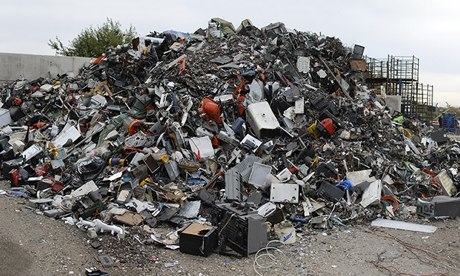This was posted on slideshare. This was written by Frank Oconnor in November, 2013.
http://www.slideshare.net/EcodesignCentreWales/design-circular-economy-tsb-keynote
Design & Circular Economy (TSB keynote)
- 1. good design and the circular economy @frank_oconnor Director @ecodesigncentre !
- 2. to believe in something, and not to live it, is dishonest. Mahatma Gandhi
- 3. we live in a throwaway society Image www.castlereagh.gov.uk ………… but there is no away
- 4. every design choice has a consequencebad design is a crime image source: Chris Jordan
- 5. 98% of products are thrown away within 6 months source: Edwin Datschefski & United NaKons University source: ads-ngo.com
- 6. 80%of environmentalimpactscan be locked-in atthe design stage
- 7. designers interactbetween industry, usersand other actors industry design consumers
- 8. designers can influencehow people consume,use, behave … industry design consumers
- 9. !our mission is to make good design happen
- 10. image source: Fuse / GeNy
- 11. the single biggest problem in communicaKon is the illusion that it has taken place George Bernard Shaw
- 12. source: Nathan Halle6
- 13. image source: jubbling.com
- 14. source: ZIPcars
- 15. source: Apple
- 16. neodymium car speaker source: Harman & wiki
- 17. polluKon true cost source: hybridcars.com
- 18. toxicity, health true cost source: dailymail.co.uk
- 19. recovery true cost source: retrench.co.uk
- 20. low carbon / high on criKcal materials source: mywindpowersystem.com
- 21. NOMAGIC MATERIALS
- 22. way forward?
- 23. 1 Cradle to Cradle “remake the way we make things” thinking about the materials we use, how our products are designed and assembled, and their cycles of use with our customers. No matter how good your products are, there comes a time when their first useful life comes to an end. In considering product life cycles Cradle to Cradle asks us to re-think the commonplace approach of “take, make & waste” and this prompted us to act. During the early stages of the design of Ara we established a relationship with one of Cradle to Cradle’s authors, renowned industrial chemist Micheal Braungart. Throughout the development we have been working with EPEA, Micheal’s C2C organisation based in Hamburg. We’ve always very carefully considered the materials that we use in our products but our aim in working with EPEA is to ensure that what we’re using is truly safe, for humans and the environment alike, and successful in technical cycles of reuse. This means looking in much more detail at every chemical disassembly tested it like mad. other plastic bases ours is 100% recyclable. And rest assured we a base without a collar insert. A simple point but unlike almost Smart design and careful material selection has enabled us to cre difficult to remove. not so great when you come to recycle it, as the collar can be ver the base. Great for not dragging your chair across the carpet but collar moulded into the plastic to stop the gas lift creeping throug sense they are, and with very few exceptions they all have a m plastic chair bases are pretty much the same, aren’t they? Well in ourselves the question - some look much better than others but Not the most complicated part on a task chair, granted, but we as recyclable. Do something really simple; make the chair base 100% we’ve ever made. armrest that’s robust, easy to use and probably the most comforta with a separate insert made from recycled foam. The result is more effectively. The traditional PU is replaced by a flexible polym than ever, using materials that could be segregated easily and recyc Our goal was to design a new arm pad that was more comforta Arm support that’s there only when you need it. controls that are easy to operate and labelled clearly. tuned and balanced to your precise needs, using adjustment smart engineering inside the mechanism means the ride can be We know that people come in all shapes and sizes. That’s why ingredient in the materials we use; to determine which inhibit this aim and need to be substituted or remove as a result. end of life Returning your ARA at ‘End of Life’ cradle to cradle Cradle to Cradle is an approach to design which looks to make us truly environmentally effective, by developing products for closed loop systems in which all the materials used are safe and beneficial - either to biodegrade naturally or to be fully recycled into high quality materials for subsequent product generations, again and again. In order for us to maximise the value of the materials used in your chair we’d like to get them back once you’ve finished with them. It’s pretty simple, all you need to do is visit our website at www.orangebox.com/endoflife.htm
- 24. 2 30% part reduction 30% faster assembly 37% weight dematerialisation
- 25. local eol dematerialise
- 26. 20 kg 15 kg
- 27. 1 ! mindset changes think ‘resource’ instead of ‘waste’ think ‘need’, ‘use’ instead of ‘consume’ transform ‘stuff’, don’t destroy it think people, think ‘share’ ensure you are contribuCng, relevant
- 28. 2 ! circular economy consideraKons consideraCon of full life cycles / system consideraCon of all ‘sustainability’ issues / focus on greatest impact no shiF of pressure between stages of life cycle / true cost creaCon of goods and services with higher overall quality and value / transformaCve use cycles embrace new models of business & ownership
- 29. 3 ! good design criteria long-‐life non-‐toxic localise renewable energy
- 30. ! designed, made, remade. zero waste. only resource passport source: Habufa
- 31. !a world where good design is the norm
- 32. thanks. good luck. ecodesigncentre.org edcshare.org @ecodesigncentre @frank_oconnor

